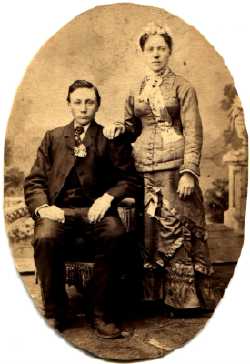Sign up for the Family Tree Newsletter Plus, you’ll receive our 10 Essential Genealogy Research Forms PDF as a special thank you!
Get Your Free Genealogy Forms
"*" indicates required fields

Several months ago, Judy Hazle submitted this photograph for identification, one of three unidentified photographs in her collection. She found it in her father’s papers after he died, and believes the last name of the couple is Dyrland, though has no way of verifying that information. All Judy knows is the couple has Norwegian heritage and hopes that by discovering a date for the image, she will be able to find out the couple’s identity.
On the back of the 3×4-inch photograph is an imprint for J.T. Relf’s Gallery of Art, Decorah, Iowa. According to the Biographies of Western Photographers: A Reference Guide to Photographers Working in the 19th Century American West (Carl Mautz), J.T. Relf operated a photo studio on Water Street in Decorah, Iowa, in 1880. While this provides a tentative date, it is necessary to analyze the costume details before making assumptions.
By comparing the woman’s dress to fashion plates in Harper’s Bazaar magazine for the 1880s, and by using Joan Severa’s Dressed for the Photographer: Ordinary Americans and Fashion, 1840-1900 (Kent State University Press), it is possible to use several clothing features in this image to establish a time frame. The woman’s dress with the overdress, gathered in the front and decorated with a bow along the edge, places the photograph between 1880 and 1882. One of the ways to determine a date for women’s dress is to examine the sleeves. In this case, her dress sleeves also suggest the early 1880s by their narrow shape and decoration at the wrist. However, her hair is from an earlier decade with a center part worn pulled away from the face. In the early 1880s, it became popular to wear curls on the forehead. This woman has not yet adopted that style, so it is possible that the image dates from 1879 to 1882 — or that she just liked wearing her hair that way.
At first glance, the photograph appears to be a wedding portrait. The woman has a white hat and the gentleman has a flower in his top buttonhole. Their pose suggests a relationship. But are they husband and wife or brother and sister? Let’s see if the accessories help provide the answer.
In the 1880s, women’s hats became larger, but in this photograph the young woman’s hat is small, sits on the crown of her head and is flattering. By comparing this woman’s hat to the magazine fashion plates in Peterson’s Magazine, it appears to date from the late 1870s when white was a popular color. The lace jabot tied around her neck is from the early 1880s. So, what is the date of this photograph based on the evidence? Her dress is in the current fashion for 1880 to 1882, but her accessories are a few years earlier. She updated her dress, but had not yet purchased a new hat.
Flowers worn in the top button of the gentleman’s coat could signify a special occasion. In the Victorian era, men and women often posed with sprigs of blossoms, even purchasing books that explained the language of botanicals and how to emphasize their significance. Perhaps the sprig in this man’s jacket had some artistic meaning. Unfortunately, it is difficult to tell the type of flower from this image.
There is a striking facial resemblance between the man and woman. They have the same nose, eyes and facial features. This may be an older sister posed with her younger brother. Genealogical data on the family may provide other clues.
It is unfortunate that so little is known about this image. Placing it in the 1880-1882 time frame doesn’t explain the occasion for the portrait or identify the individuals. In order to find out more about the photograph, Judy should copy and show it to as many family members as possible. Perhaps another copy exists in a distant relative’s collection.
ADVERTISEMENT

